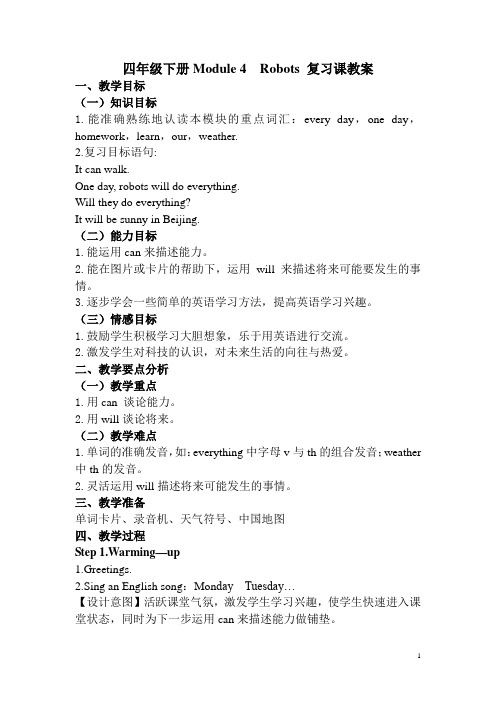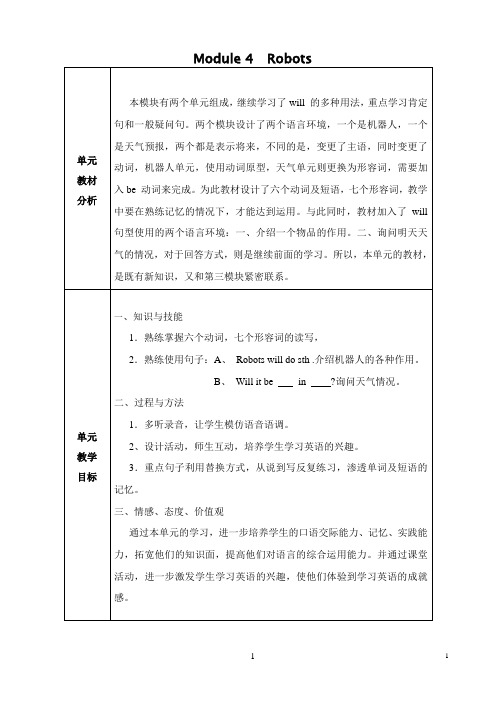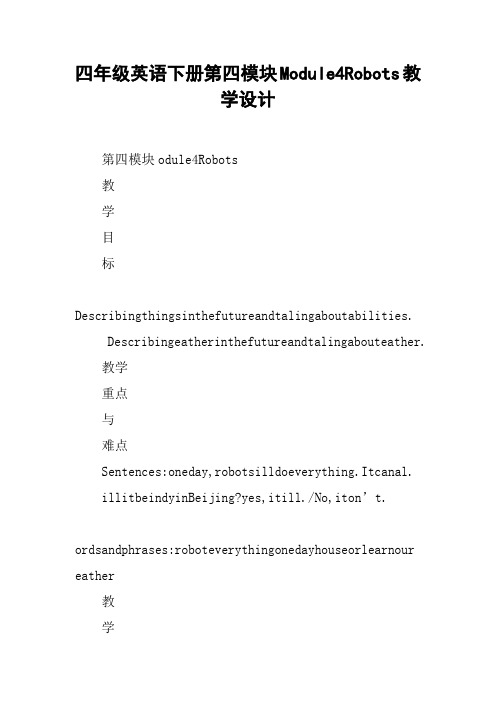《Module 4 Robots》教学设计
- 格式:doc
- 大小:85.17 KB
- 文档页数:21

外研社(三起)四年级英语第四册:Module 4 Robots Unit 1 Robots will do everything 教案教学目标•能够听懂并理解关于机器人的简单英文对话。
•能够用简单的英语表述机器人以及它们可以完成的任务。
•能够与同伴合作完成机器人的设计和介绍。
•通过本单元的学习,拓展学生的知识面,激发学生的创新思维,培养学生的英语交流能力和合作意识。
教学重点•能够听懂并理解关于机器人的简单英文对话。
•能够用简单的英语表述机器人以及它们可以完成的任务。
教学难点•能够与同伴合作完成机器人的设计和介绍。
教学准备•教材:外研社(三起)四年级英语第四册 Module 4 Robots Unit 1。
•大屏幕、投影仪等教学设备。
•学生们自己带来的废旧材料、未成型材料等,用于机器人的设计制作。
教学过程导入(5分钟)1.教师简单介绍机器人的发展历程,并展示一些与机器人有关的图片或视频,激发学生对机器人的兴趣和好奇心。
呈现(15分钟)1.教师放映课文 Unit 1 Robots will do everything 的视频,引导学生听视频中机器人相关的对话。
2.教师根据视频展示关键词汇:robot, do housework, do the dishes, do the laundry, cook, take care of children, walk the dog 等,并通过图片、动作等方式模拟机器人的各项任务,提高学生对这些任务的理解。
合作探究(20分钟)1.教师告知学生,他们需要分为若干小组,每组设计一个未来的机器人,并为机器人取一个英文名称。
2.学生们自己带来废旧材料等,根据小组的设计图纸开始机器人的设计和制作。
3.在制作过程中,教师为学生们提供必要的指导,督促学生们积极参与制作,呈现他们的天马行空的创意。
4.设计完成后,每个小组需要介绍他们的机器人的名称、功能、外形等英文特点。
学生可以通过图片、口语交流等方式进行展示。

《Module 4 Robots Unit1 Robots will doeverything.》教学设计《Module 4 Robots Unit1 Robots ill do everything.》教学设计一、教材分析:Module 4 Book 4 的主题为"Rovots',"Unit 1 Rovots ill do everything.'的语功能是连续学习用"ill'谈论将来可能发生的事情。
本单元主要以同学特别感到饶有兴趣的"robot'为主体,以"They ill do everything.'为主要句型,话题贴近同学的日常生活,使同学能够从自身兴趣动身,在真实的语言环境中,主动运用所学学问,探讨机器人的将来进展趋势,充分体现了同学在学习过程中的主体地位。
二、学情分析:本课的教学对象是四班级同学。
他们已经有肯定的英语学习基础,在新语言学问点的学习过程中,老师应主动运用教材所供应的同学宠爱的机器人话题,给同学创设相关的语言情境,让同学在情境中自然习得、自然运用,大胆实践,形成主动的学习观和自主学习的力量。
在新标准英语第三册中,同学已经学过用情感动词"can'来描述力量,在第四册第三模块中同学又初步学习了第一、其次人称用"ill'来描述将来可能发生的事情。
所以,本课的教学内容只是把同学已经学过的学问有机地结合,改换人称,同学把握起来比较简单。
(一)学问目标1.能听懂、会说并认读以下单词:robot,everything,houseork,learn,our;短语:one day.2.能听懂、会说并认读以下句子:"Robots ill do everything.' "Will they do the houseork?' "Yes,they ill./No,they ont.' (二)力量目标1.能够流利地朗读课文对话并分角色进行表演。

四年级下册Module 4 Robots 复习课教案一、教学目标(一)知识目标1.能准确熟练地认读本模块的重点词汇:every day,one day,homework,learn,our,weather.2.复习目标语句:It can walk.One day, robots will do everything.Will they do everything?It will be sunny in Beijing.(二)能力目标1.能运用can来描述能力。
2.能在图片或卡片的帮助下,运用will来描述将来可能要发生的事情。
3.逐步学会一些简单的英语学习方法,提高英语学习兴趣。
(三)情感目标1.鼓励学生积极学习大胆想象,乐于用英语进行交流。
2.激发学生对科技的认识,对未来生活的向往与热爱。
二、教学要点分析(一)教学重点1.用can 谈论能力。
2.用will谈论将来。
(二)教学难点1.单词的准确发音,如:everything中字母v与th的组合发音;weather 中th的发音。
2.灵活运用will描述将来可能发生的事情。
三、教学准备单词卡片、录音机、天气符号、中国地图四、教学过程Step 1.Warming—up1.Greetings.2.Sing an English song:Mon day Tuesday…【设计意图】活跃课堂气氛,激发学生学习兴趣,使学生快速进入课堂状态,同时为下一步运用can来描述能力做铺垫。
Step2.Review1.Leading—in.T:I’m an English teacher. I can speak English.I can sing English songs. Can you remember what robots can do now?And what will they do one day? Let’s listen to the tape.2.Text(1)Unit 1①Listen and review.②Listen and repeat.③Listen and repeat in roles.【设计意图】通过反复听读课文录音,让学生随着听音次数的增多,达到知识浮现率的逐步提高,训练学生的语音语调更标准地道。

外研版英语四年级第四模块集体备课Module 4 Robots一、教学内容:外研版小学英语三起第四册Module 4的主题是“Robots”.Unit 1 Robots will do everything.延续了Module 3的知识目标,继续学习用“will”谈论将要发生的事情。
二、教学重点难点:重点:1、能借助“can”来描述能力。
2、能运用“will”来描述即将发生的事情难点:能够正确理解运用Will they..? 句型及做出正确的回答。
三、原虚化目标:(1)培养学生在活动中体会英语学习的乐趣,使他们在小组中积极与他人合作,相互帮助,共同完成任务。
(2)培养学生学习英语的兴趣;让学生认识到高科技对我们日常生活产生的影响,培养学生尊重科学、热爱科学的积极情感四、通过研讨得到的实化目标:(1)能听懂、会说并写出以下单词和短语robot 、everything、one day、housework 、learn、our (2)能听懂、会说并认读以下句子:One day,robots will do everything.Will they do the housework? Yes,they will./No,they won’t.五、评价方法设计1.有的时候,我们需要做很多的事情,这会使我们精疲力竭,这个时候要是有人能帮帮我们那该多好啊!我们的好朋友大明就有这样一个好帮手,他是谁呢?他有能帮大明做些什么呢?引出Robots2.播放课文听力。
出示机器人走的图片对学生进行提示。
3.学生根据图片回答It can walk。
出示机器人说话的图片对学生进行提示。
4.学生根据提示回答It can talk.出示课文图片提示学生回答It will do the housework.出示课文图片提示学生回答It will help children learn.学生分组讨论还希望机器人能够做的5. 学生分组讨论还希望机器人能够做的事,然后教师总结:The robot can’t do these things now,but one day they will do everything.。


四年级英语下册第四模块Module4Robots教学设计第四模块odule4Robots教学目标Describingthingsinthefutureandtalingaboutabilities.Describingeatherinthefutureandtalingabouteather.教学重点与难点Sentences:oneday,robotsilldoeverything.Itcanal.illitbeindyinBeijing?yes,itill./No,iton’t.ordsandphrases:roboteverythingonedayhouseorlearnour eather教学设想开展游戏“Guess—hattherobotilldo?”。
以小组为单位选派代表扮演机器人,带上“机器人”帽子上前做动作,其他小组使用“youill……”或“illyou……”句型进行猜测,优胜者给予奖励。
让学生通过看电视,看报纸等各种渠道调查第二天各地的天气情况,制作出自己的天气预报表,然后做“小小天气预报员”,使用英语向同学们预报最近各地的天气情况。
课题odule4Unit1:Robotsilldoeverything课时新授教学目标Beabletosay:Itcanal.Robotsilldoeverything.Beabletotalaboutsoethingith“ill”.教学重难点Beabletodescribetheabilitiesith“can”.准备arecorder教学过程教师活动学生活动设计意图I.arerontheboarddraarobot.Thenrite“Itcan….”undertherobot.pointtotherobotagainandsay,“Itcanread”andthenpicupabooandpretendtoread.II.NelessonHavethestudentslooatthepicture.Asquestioninchinese.NosaythatI;goingtocalloutthenaesofdiffHavepairsofst udentsetothefront.StudentsAsayshattherobotcandoandstudentBdoestheacti on.Looatthepicturesandanserthequestion.Aftertalingabouttherobots,theycaniprovetheinterestsaboutthe.Thechildrenareveryhappy.Toiprovethestudents’abilityoftranslation.教师活动学生活动设计意图erentobjectsandpeopleinthepicturesandthestudentshavetopointtothe.ExplaintothestudentI’goingtopointtothedifferentpicturesinActivity3andaes tateentsaboutthe.Doalotofexaplesiththeclass.Listentotheteacherandpointtothe.Havethestudentscontinuetheactivityinpairs.Afterthreeturnstheyshouldsaproles.Thepupilsareableto describetheabilitiesith“can”.课后反思Studentsareinterestedintherobot,especiallytorecordi ng,sotheycanreaditveryell.Robotilldoeverything.illtheydothehouseor?yes,theyill.No,theyon’t.课题Unit2:illitbeindyinBeijing?课时拓展教学目标Beabletosay:ItillbeindyinBeijing.illitbeindyinBeiji ng?yes,itill./No,iton’t.Beabletosaytheeatherreport.教学重难点Beabletotalabouttheeather.准备arecorder教学过程教师活动学生活动设计意图I.arerIntroducesoeofthenevocabularybydraingsoepicturestor epresentthedifferenteatherpatterns.ritetheappropiate‘eather’ordsunderneathandplacethepicturesonthealloftheclassroo II.NelessonHavethestudentsclosetheirboos.calloutacityandtheNoperforiestoshothestudentstheeaningoftheothereathe rconditionsoraeastateentandhavethestudentstodoanappropriateie.closetheirboossaythetypeofeatherinthecity.Thiscanhavethestudents’atosphereToincreasethepupils’listeningability.教师活动学生活动设计意图typeofeatherinthatcity.Dolotofexaples.Thenhavethestudentscontinuetheactivityinpairs.Listentothetapeandraedafterit.Doalotofpracticetofailiarisethestudentsiththenevocabulary.Thestuden tsshouldcontinuetheactivityinpairs.Listentothetapea ndreadafterthetapetogether.Beabletoiprovethestudents’studinterests.课后反思ecan’tsay“berain”and “besno”,thisisalittledifficulttosoepupils.theyusu allysay“berain”.Doorereading.illitbeindyinBeijing?behotsunnindcoldrainsno课题Robots课时综合教学目标Beabletosay:illitbeindyinBeijing?yes,itill./No,iton ’t.illitbesunnytoorro?Beabletosaythechant.教学重难点Beabletotalabouttheeatheraboutthefuture.准备arecorder教学过程教师活动学生活动设计意图I.arergreetings.Loooutsideandsay:It’s[typeofeather]today.Hold uporpointtotheappropiateeathersybol.I’llhavetosay‘raining’or‘snoing’ifthereisrainorsno.Follothesaeprodureforthereainingsybols.eachingHavethestudentslooattheboosandsayhattheythinthechantcapetheteacher’sexanple,andasandanserinpairs.Looattheboosandsayhattheythinthechanti llToincreasethepupils’activities.Tononeords’pronunciation.Listenoreties,sotheycan教师活动学生活动设计意图illbeabout.Asthestudentshatistheirfavouritetieofyearandhy.Find outiftheypreferbeinghotorcold.Playthetapeandhavetheclasssaythechantastheylisten.Playagaeillitbesunnytoorro?beabouttheeather.Listentothetapeandsaythechant.Playagaeandorinpairs.spescorrectl Studyinpairsthepupilscanhelpeachother.课后反思“ill”and“begoingto”expressthenearlysaeeaning.butalsohassoedefference.rainsno。
《Module 4 Robots》教学设计Unit 1 Robots will do everything.知识目标:It can walk.It can talk.Robots will do everything.能力目标:用will谈论将来可能发生的事情。
用情态动词can描述能力。
Key points:It can walk.Robots will do everything.一、热身复习1. Sing a song : London bridge is falling down2.TPR活动:Do as I say .用I can...描述:I can run./jump/play football/play basketball/play the flute/row a boat/take pictures/write a letter/sing a song...3.Review “a week”. Ask Ss: How many days are there in a week? What are they?(Monday Tuesday Wednesday Thursday Friday Saturday &Sunday )二、任务呈现与课文导入(Presentation):1.师做疲倦状说:I'm very tired. Who can help me? Can robots help me?出示robots的玩具模型和图片并教学单词robot,举起两个机器人玩具讲授“robots”.Show &say: a robot two robotsToday we are going to talk about the robots.三、新课学习(test learning):T: Have you got a robot? OK, our good friend Daming has got a robot. Let’s listen to the tape carefully &circle the new words on the Bb.教学生词:robot, everything , housework, one day, learn ,our .小组学习新单词:(Practice in groups:)Group show:小组评价:Listen again and try to answer the question.模仿walk和talk的动作.Ss: It can walk. It can talk.Robots will do everything.1. 老师教学生读句子:It can walk/talk.小组学习新句子:(Practice in groups:)Group show:小组评价:2. T: Answer the question: What will the robots do? Please look at your books on page 14 and 15. Find out the answers.3. 看书,听录音。
新标准英语三年级起点第四册教案Module 4 RobotsUnit 1 Robots will do everything.Function: Describing things in the future and talking about abilities Teaching points: 1.Sentences: One day, robots will do everything.2. Words and phrases: robot everythingone day housework learn our that3. Using will to describe things in the futureTeaching properties: cards tape-recorder CAITeaching procedures:(1) Warming up: ---Greeting.---Listen and act : e.g. wash clothes watch TV run walk play the flute play football jump do homework make a cake row a boat play table tennis (运用肢体语言来复习动词及动词词组,为本课will 的学习做好铺垫)(2) Presentation: Show a robot to the class and say “Today we’re going to talk about the r obots.”Describing the robots, it can sing. It can dance. One day, robots will do everything. (运用图片展示robot的含义)Ask t o the students “What else will the robots do?” Show the CAI to students. (让学生看课件了解机器人能做什么不能做什么)Now show the text to the students. Look at the book and ask. What can Daming’s robot do? Will robots do the housework? Will robots help children learn?...Write the answers on the board: It can walk.Then drill this sentence and then change the word “walk”.Talk about the sentences: They will do the housework. They will help children learn.Write the sentence on the board One day, robots will do everything. (用磁卡带替换动词及动词词组,让学生运用所学。
(外研版)四年级英语下册教案Module4Module 4 Robots 单元分析本模块由unit1Robots will do everything和unit2 Will it be windy in Beijing两个单元组成。
分别向我们介绍怎样用‘will’谈论将来可能发生的事情;运用动词‘can ’描述能力;谈论将来的天气状况等等。
解释‘rain’与‘rainy’的区别:‘rain’所指的是短时性的降雨,而‘rainy’的意思是“多雨的”,指的是一段时期内的气候特征。
与它一样的还有‘snow’与‘snowy’的区别。
Unit 1 Robots will do everything.Teaching aims: It can walk .Robots will do everything.Teaching Importance and difficulties:How to use 'will'and 'can'?Teaching tools:RecorderTeaching steps:step1: Warm up1)Sing a song2) On the board draw a robot (draw a square for the head, rectangle for the body, rectangles for the arms and legs, squares or rectangles for the eyes, nose and mouth on the head).3)Then write 'It can...'under the picture.4)Point to the robot and say,'This is a robot.'Have the students repeat thesentence .Then say, 'It can walk' and begin to walk around the class.Try to walk in a very awkward'robot'way.(do more example by pointing to the robobt and saying,'It can...'and then miming the action.)5) Now have individual students say something they think the robot can do and you have to mime the action.6)Have pairs of students come to the front .Student Asays what the robot can do and StudentB does the action. You may want to write a list of suitable verbs on the board.Step 2: Learning and practising1)Have the students look at the pictures.Ask questions in Chinese ,e.g. What is Sam looking at in picture 1? What is the robot doing in picture2? What has the robot done in the last picture?2)Now say that you are goint to call out the names of different objects and people in the pictures and the students have to point to them.3)Point and sayExplain to the students that you are going to point to the different pictures in Acitivity 3 and make statements about them . They have to tell you if they are true or false by calling out'True'or'False'.(do a lot examples with the class.)4)Now have the students sontinue the activity in pairs.After three turns,they should swap roles.Step 3 : Homework。
小学英语骨干教师“说课标、说教材教法”新标准三起第四册Module 4 Robots光辉中心小学赵熠一、说课标1、说课程目标:《英语课程标准》的总体目标是:通过英语学习使学生形成初步的综合语言运用能力,促进心智发展,提高综合人文素养。
综合语言运用能力的形成建立在语言技能、语言知识、情感态度、学习策略和文化意识等诸方面整体发展的基础之上。
强调以语言技能、语言知识、情感态度、学习策略,文化意识的发展为基础,体现“知识与技能、过程与方法、情感态度与价值观”三位一体的课程功能。
强调让学生通过感知、体验、实践、参与和合作等方式,在用中学,学中用。
在义务教育阶段,我们从3年级开设英语课程,4年级应完成一级目标。
2、说内容标准。
四年级学生在综合语言运用能力方面应达到一级目标。
一级:对英语有好奇心,喜欢听他人说英语。
能交流简单的信息,表达简单的情感和感觉。
能书写字母和单词。
对英语学习中接触的外国文化习俗感兴趣。
能根据教师的简单指令做游戏、做动作、做事情(如涂颜色、连线)。
能做简单的角色扮演。
能唱简单的英文歌曲,说简单的英语歌谣。
能在图片的帮助下听懂和读懂简单的小故事。
具体为:听做1.能根据听到的词语识别或指认图片或实物;2.能听懂课堂简短的指令并做出相应的反应;3.能根据指令做事情,如:指图片、涂颜色、画图、做动作等;4.能在图片和动作的提示下听懂简单的小故事并做出反应。
说唱1.能根据录音模仿说话;2.能相互致以简单的问候;3.能相互交流简单的个人信息,如:姓名、年龄等;4.能表达简单的情感和感觉,如:喜欢和不喜欢;5.能够根据表演猜测意思、说出词语;6.能学唱英语儿童歌曲和歌谣15首左右;7.能根据图、文说出单词或短句。
玩演1.能在教师的指导下用英语做游戏并在游戏中进行简单的交际;2.能做简单的角色表演;3.能表演简单的英语短剧。
读写1.能正确书写字母和单词。
2.能看图识字;3.能在指认物体的前提下认读所学词语;4.能在图片的帮助下读懂简单的小故事;5.能模仿范例写句子。
单元分析本模块由unit1Robots will do everything和unit2 Will it be windy inBeijing两个单元组成。
分别向我们介绍怎样用‘will’谈论将来可能发生的事情;运用动词‘can’描述能力;谈论将来的天气状况等等。
解释‘rain’与‘rainy’的区别:‘rain’所指的是短时性的降雨,而‘rainy’的意思是‚多雨的‛,指的是一段时期内的气候特征。
与它一样的还有‘snow’与‘snowy’的区别。
Module 4 Robots教学设计Unit 1 Robots will do everything.Teaching aims: It can walk .Robots will do everything.Teaching Importance and difficulties:How to use 'will'and 'can'?Teaching tools:RecorderTeaching steps:step1: Warm up1)Sing a song2) On the board draw a robot (draw a square for the head, rectangle for the body, rectangles for the armsand legs, squares or rectangles for the eyes, nose andmouth on the head).3)Then write 'It can...'under the picture.4)Point to the robot and say,'This is a robot.'Have thestudents repeat the sentence .Then say, 'It can walk'and begin to walk around the class.Try to walk in a very awkward'robot'way.(domore example bypointing to the robobt and saying,'It can...'and thenmiming the action.)5) Now have individual students say something theythink the robot can do and you have to mime the action.6)Have pairs of students come to the front .Student Asays what the robot can doand StudentB does the action. You may want to write a list of suitable verbs onthe board.Step 2: Learning and practising1)Have the students look at the pictures.Ask questions in Chinese ,e.g. What isSam looking atin picture 1? What is the robot doing in picture2?What has the robot done in the last picture?2)Now say that you are goint to call out the names ofdifferent objects and people in the pictures and thestudents have to point to them.3)Point and sayExplain to the students that you are going to pointMore: Edit:key071wkto the different pictures in Acitivity 3 and make statements about them . Theyhave to tell you if they are true or false by calling out'True'or'False'.(do alotexamples with the class.)4)Now have the students sontinue the activity in pairs.After three turns,they should swap roles.Step 3 : HomeworkUnit 2 Will it be windy in Beijing教学设计Teaching aims: It will be windy in Beijing.Will it be windy in Beijing?Yes,I will.\No,I won't.Teaching Importance and difficulties:Discussion the weatherTeaching tools:RecorderTeaching steps:step1: Warm up1)Sing a song2)Introduce some of the new vocabulary by drawingsome pictures to represent the different weather patterns. Copy the picturesfrom the textbook,drawyour own or get the students to draw some.3)Write the appropriate'weather'words underneathand place the pictures on the wall of the classroom.4)Look outside and say,'It's...today' Hold up or point to the appropriateweather symbol. You will have to say'raining' or 'snowing'if there si rain orsnow. Note that you will also have to teach'cloudy'as it is in the poem.5)Now perform mimes to show the students the meaning of theother weatherconditions or make a statement and have the studets do an appropriate mime.Step 2 : Learning and practising1)Play this memory game before doing Activity 2. Have the students close theirbooks.Call out a cityand the students have to say the type of weather inthat city.(do a lot of examples. Then have the studentcontinue the activity in pairs. After three turns, theyshould swap roles.)2)Have the students look at the books and say what they think the chant will beabout(the weather)3) Ask the students what is their favourite time of year and why. Find out ifthey prefer being hot or cold4)play the spoken version of the chant and get thestudents to repeat.5)Play the tape and have the class say the chant asthey listen.6)Divide the class into three groups. Explain that eachgroup will say one stanza of the chant.7)Explain to the students that they can do some actions as they say the chant. They can move their bodies slightly as they say'windy'to indicate that they are being blown about by the wind. They can fan themselves with their hands as they say the word'hot'When they say'cloudy',They should look upwards as though they are looking aat the sky.They can shiver as they say'snow'.When they say 'play'in the last stanza, they should give a big smile.Step 3 : HomeworkUnit7 At weekends单元教材分析:本单元谈论的话题是周末活动,教师可以结合学生用书四年级下册Unit2 After school和五年级上册unit4 Hobbies的内容,综合呈现语言知识。
教师可以和学生一起复习有关课外活动和业余爱好的词汇,作为导入或巩固活动。
涉及的周末活动有上网和远方家人聊天、放风筝、看电影、野餐等,教师可以在教学中利用挂图、照片或多媒体呈现一些孩子周末活动的情景,也可以要求学生课前准备一张家庭周末活动的照片。